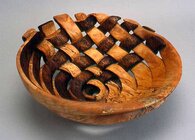This forum debate has been invaluable. It has confirmed the huge popularity of the mistaken belief that differences in turners’ innate qualities should cause different techniques to be adopted by different turners. Because of this belief AAW members are unknowingly likely to be taught and adopt suboptimal techniques. Also, once an AAW member has adopted a suboptimal technique, the probability of that member accepting advice which would improve his (no women have participated in the debate) turning is next to nil. This makes it even more important that the optimum techniques are identified and promoted so that those beginners who want to turn as well as they reasonably can are not diverted into learning suboptimal techniques.
Appears to continue to be a great deal of folks disagreeing with you , and I suspect a large portion of it may simply be that you are being rather vague.
Optimal Technique? Give me an example (perhaps do a video illustrating it, or go over to youtube and find what you consider to be the optimal technique and then find another one for the same purpose that is sub-optimal... After all, a picture is worth a thousand words, no?)
So far I have not seen a single specific detail of what exactly you might call optimal technique, all I have read of your posts so far is some vague notion that there is an optimal technique out there, but you have not offered any concrete examples?
Grinding angles? Meh - the wood does not care if you ground it to a 30 degree or 45 degree or anywhere in between, all that counts is a sharp cutting edge. (and how is a grinding angle a "technique", anyway?)
There has been endless debate on just how sharp IS Sharp (See other forum posts regarding grinding wheel grits , not to mention the extensive work one of these guys from Australia of NZ did on comparing how fine a grit with what type of steel, and finding that in some cases there's actually a point of diminishing returns...)
Likewise, if I could grind to a 45 degree angle and keep that edge KEEN (as in no crumbling of edge) with a better grade of steel I could easily "prove" that 45 degree angle beats your 30 degree angle on a lesser quality steel (and in some cases, a better quality steel takes a better edge but breaks away much more easily on a 30 degree angle than it does on 45 degrees) So, what may be optimal for a M2 HSS gouge may not be so optimal when you get into the more exotic steels. So I will still argue that what is optimal can often depend not only on the turner, but on the tool itself, as well as the wood being worked. (and/or the lathe) - BUT none of that is necessarily "technique"
General Definition of Technique
Technique: A specific method, procedure, or skill used to accomplish a task, especially one that requires precision, expertise, or artistry.
-- So, how does sharpening angle suddenly become a technique? SO again, what exactly is an optimal technique?
Further, with a great deal of woodturning being more about the art and the artist these days, I'd submit that if you try to get everyone to use the same technique, you'll likely be seeing similar results in the output from those turners - That'd be great for Production turners, but not so great when an artist is struggling to make their art unique (DO you think Leonardo Da Vinci and Salvador Dali used the same techniques? Rather doubtful, no? So, which technique is better or most optimal? Da Vinci's? Dali's ? Someone else's?)

